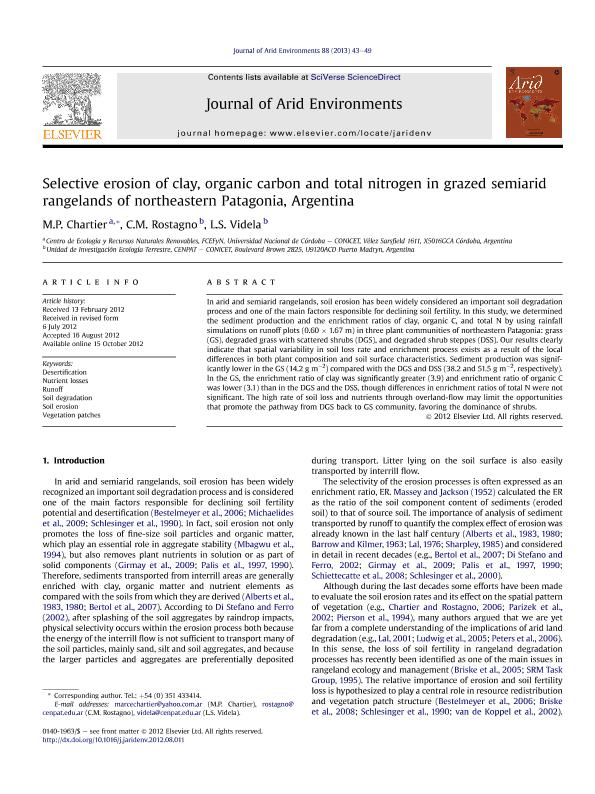Artículo
Selective erosion of clay, organic carbon and total nitrogen in grazed semiarid rangelands of northeastern Patagonia, Argentina
Fecha de publicación:
01/2013
Editorial:
Elsevier
Revista:
Journal of Arid Environments
ISSN:
0140-1963
Idioma:
Inglés
Tipo de recurso:
Artículo publicado
Clasificación temática:
Resumen
In arid and semiarid rangelands, soil erosion has been widely considered an important soil degradation process and one of the main factors responsible for declining soil fertility. In this study, we determined the sediment production and the enrichment ratios of clay, organic C, and total N by using rainfall simulations on runoff plots (0.60 × 1.67 m) in three plant communities of northeastern Patagonia: grass (GS), degraded grass with scattered shrubs (DGS), and degraded shrub steppes (DSS). Our results clearly indicate that spatial variability in soil loss rate and enrichment process exists as a result of the local differences in both plant composition and soil surface characteristics. Sediment production was significantly lower in the GS (14.2 g m−2) compared with the DGS and DSS (38.2 and 51.5 g m−2, respectively). In the GS, the enrichment ratio of clay was significantly greater (3.9) and enrichment ratio of organic C was lower (3.1) than in the DGS and the DSS, though differences in enrichment ratios of total N were not significant. The high rate of soil loss and nutrients through overland-flow may limit the opportunities that promote the pathway from DGS back to GS community, favoring the dominance of shrubs.
Palabras clave:
Desertification
,
Nutrient Losses
,
Runoff
,
Soil Erosion
Archivos asociados
Licencia
Identificadores
Colecciones
Articulos(CCT-CENPAT)
Articulos de CTRO.CIENTIFICO TECNOL.CONICET - CENPAT
Articulos de CTRO.CIENTIFICO TECNOL.CONICET - CENPAT
Citación
Chartier, Marcelo Pablo; Rostagno, Cesar Mario; Videla, Lina Sonia; Selective erosion of clay, organic carbon and total nitrogen in grazed semiarid
rangelands of northeastern Patagonia, Argentina; Elsevier; Journal of Arid Environments; 88; 1-2013; 43-49
Compartir
Altmétricas




